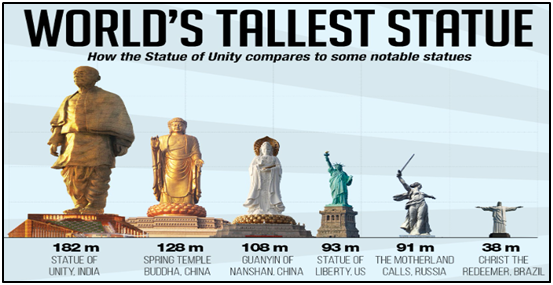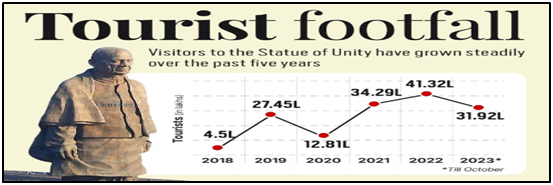Contributions of Sardar Patel: PM Modi pays tribute at Statue of Unity in Gujarat
01-11-2023
01:59 PM
1 min read

Why in News?
- The PM of India paid tribute to Sardar Vallabhbhai Patel at the Statue of Unity in Gujarat on the birth anniversary (148th on October 31, 2023) of India's first Home Minister, which is celebrated as National Unity Day.

What’s in Today’s Article?
- Sardar Patel and His Contributions in Building Modern India
- About the Statue of Unity
- Five Years of the Statue of Unity - What has Changed in the Region?
Sardar Patel and His Contributions in Building Modern India
- Vallabhbhai Jhaverbhai Patel (31 Oct 1875 - 15 Dec 1950), commonly known as Sardar Vallabhai Patel, was an Indian independence nationalist and barrister who served as the first Deputy PM and Home Minister of India from 1947 to 1950.
- He was a senior leader of the Indian National Congress, who played a significant role in the country's struggle for independence and its political integration.
- He was appointed as the President of Indian National Congress in its 45th session at Karachi in 1931.
- The Karachi session is memorable for a resolution on Fundamental Rights and the National Economic Programme.
- The resolution guaranteed basic civil and political rights to the people.
- One of Mahatma Gandhi's earliest political lieutenants, he organised peasants from Kheda (1918), Borsad (1923) and Bardoli (1928) in Gujarat in non-violent civil disobedience against the British Raj.
- It was the women of Bardoli who bestowed the title Sardar (Chief or Leader)for the first time upon Vallabhbhai Patel.
- It was after Bardoli that Sardar Patel (who led the movement) became one of India's most important leaders.
- Patel's commitment to national integration (persuaded almost every [~562] princely state to accede to India) in the newly independent country earned him the sobriquet "Iron Man of India".
- He is also remembered as the "patron saint of India's civil servants" for playing a pioneering role in establishing the modern All India Services system.
- He referred to the IAS as India's steel frame, referring to the bureaucratic structure, which was expected to build the new nation.
- The Statue of Unity, the world's tallest statue which was erected by the Indian government, was dedicated to him on 31 October 2018.
About the Statue of Unity
- The Statue of Unity is the world's tallest statue [construction cost of ₹27 billion (US$422 million)], with a height of 182 metres (597 feet), located near Kevadia/ Ekta Nagar - a town in the Narmada district of Gujarat.
- It is dedicated to Sardar Vallabhbhai Patel, the architect of independent India.
- The statue is located on the Narmada River on the Sadhu Bet hillock, against the magnificent background of the Satpura and Vindhyachal hills.
- It is a statue (primary materials used to construct the Statue are copper, bronze, and steel) constructed by Indian company Larsen & Toubro and designed by Indian sculptor Ram V. Sutar.
- It was inaugurated by the PM of India on 31 October 2018 - the 143rd anniversary of Patel's birth.
Five Years of the Statue of Unity - What has Changed in the Region?
- Since the inauguration of the statue, Ekta Nagar has emerged as one of the state’s top tourist destinations, which include Gir Sanctuary, Rann of Kutch, Pavagadh, Somnath, Dwarka and Ahmedabad.
- Once the epicentre of one of India’s most vocal agitations against the construction of a dam (Sardar Sarovar) on the Narmada, Ekta Nagar today boasts of annual tourist footfall of over 20 lakhs from 4.5 lakh in 2018.
- An entire ecosystem has sprung up in Ekta Nagar to cater exclusively to the needs of the over 20 lakh tourists who descend here annually.
- Over the last five years, infrastructure (roads, buildings, uninterrupted power supply, a railway station, etc) in Ekta Nagar has changed beyond recognition.
- The tourism circuit has resulted in opportunities for the residents (especially for women who run e-rickshaws, homestays, canteens, etc).
- Changes brought about by the statue are not limited to just Ekta Nagar. They are visible along the 90-km four-lane highway from Vadodara till the tourist attraction too.
Q1) What triggered Borsad Satyagraha in pre-independent India?
The Borsad Satyagraha was observed under the leadership of Sardar Vallabhbhai Patel in Anand (Gujarat) in 1923. The Satyagraha was in opposition to the punitive tax of over Rs 2.40 lakhs imposed on villages on the pretext of the police force providing protection from dacoits of that area.
Q2) What was the main reason for Kheda Satyagraha of 1918 in pre-independent India?
Kheda Satyagraha was mainly focused on the peasant-Patidar community of Kheda (Gujarat), who refused to accept a 23% tax increase enforced on them despite a devastating crop failure and plague and cholera outbreak.
Source: PM Modi pays tribute to Sardar Patel at Statue of Unity in Gujarat | IE



